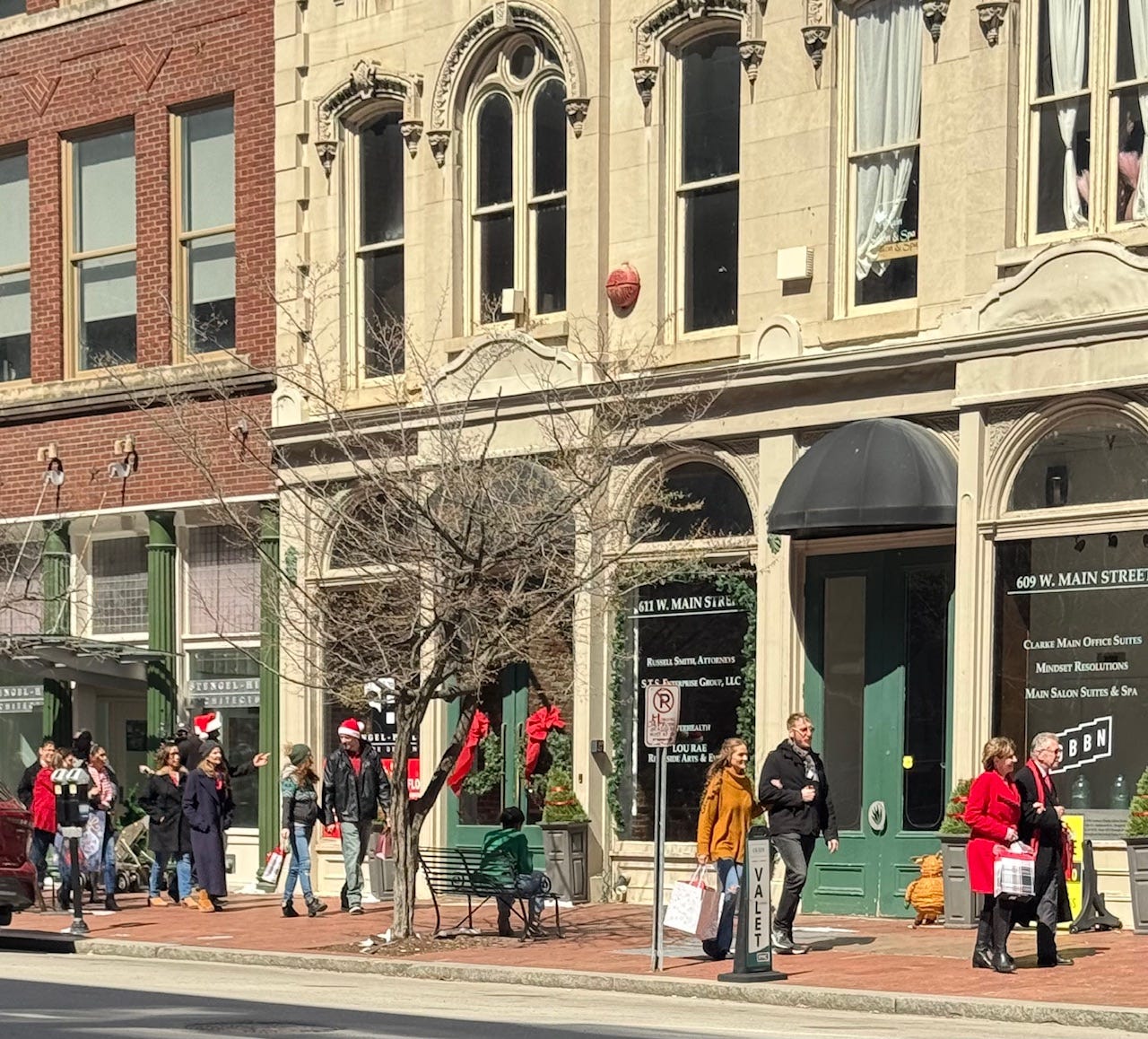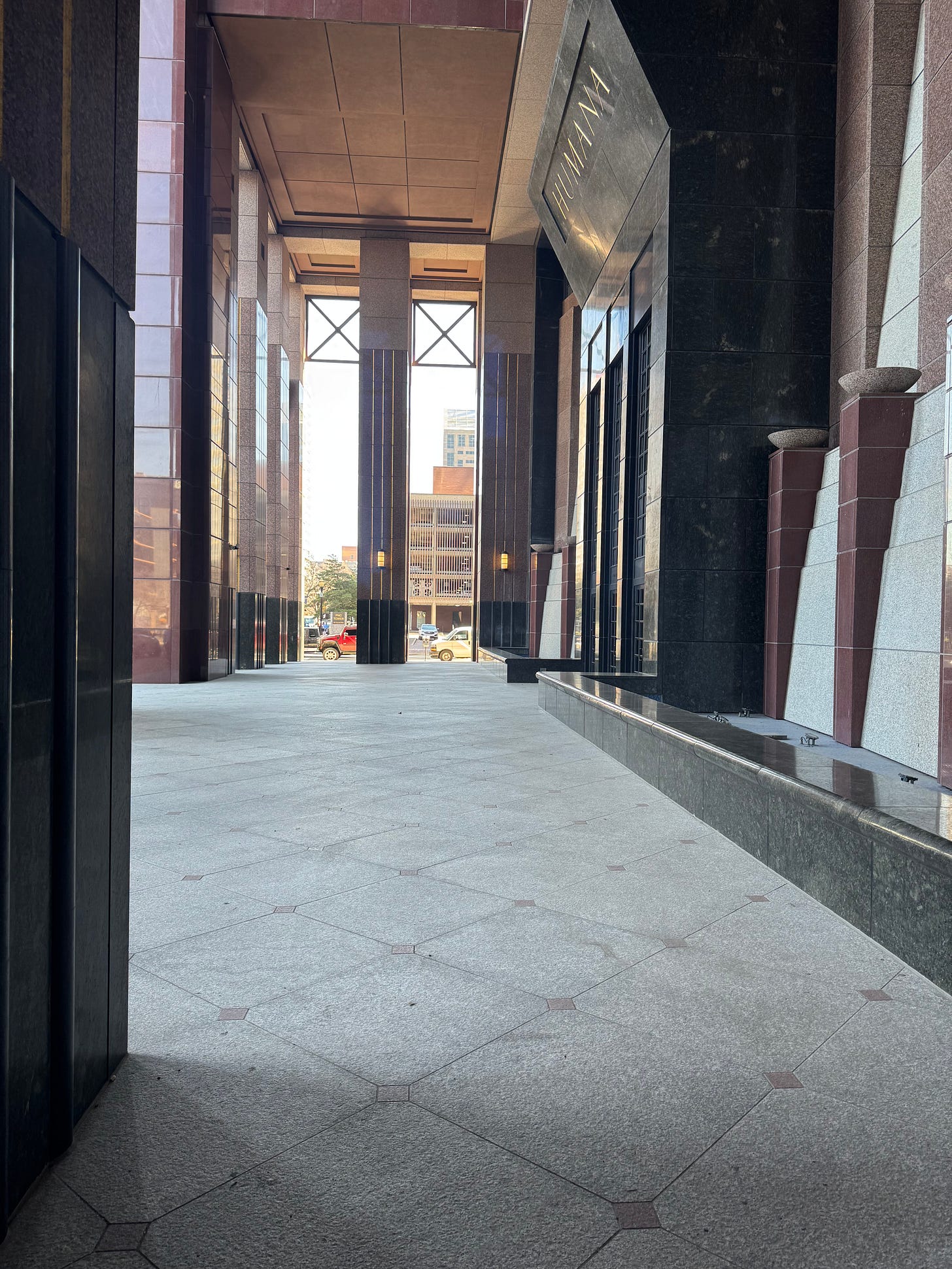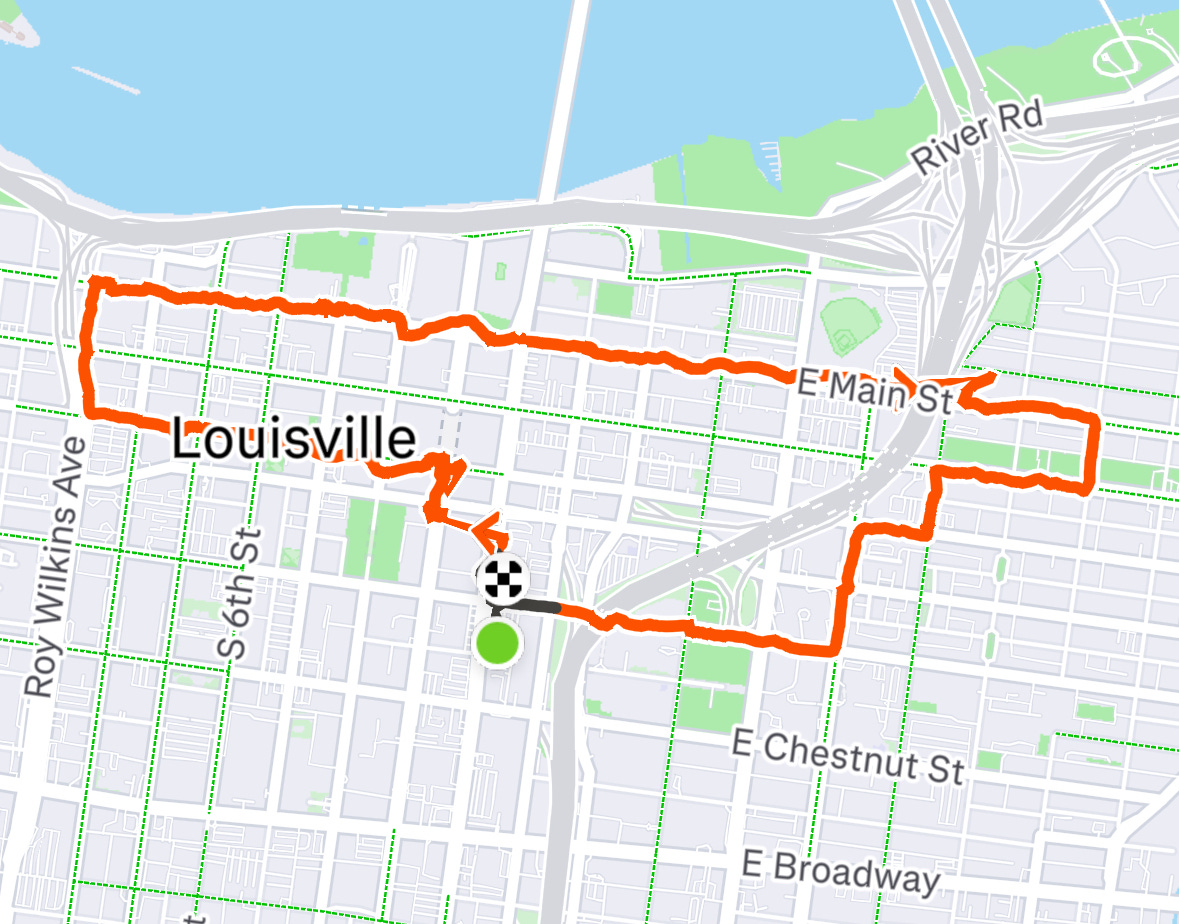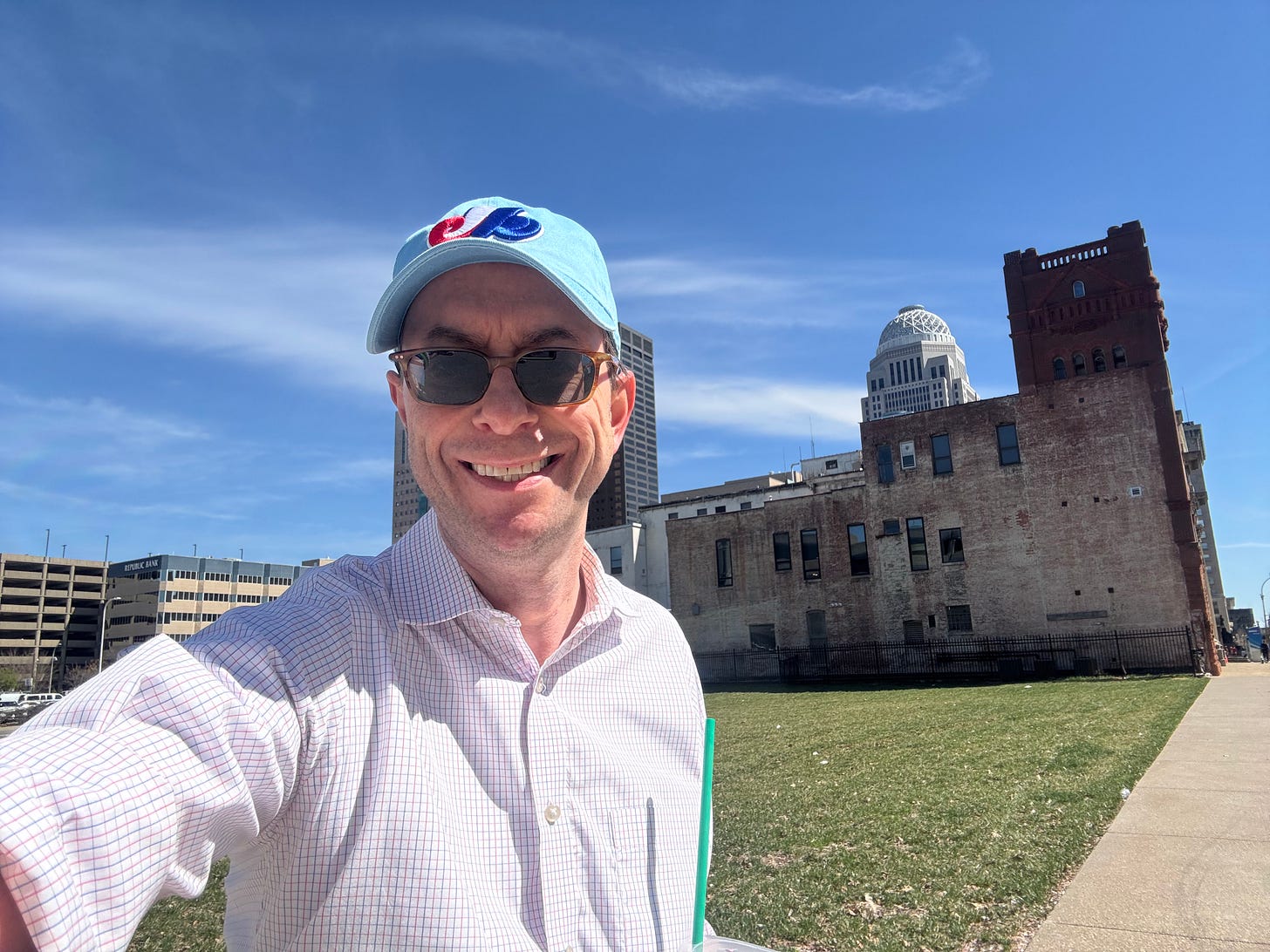Will Louisville Ever Have A Vibrant Downtown Again?
Continuing a walking story about downtown Louisville
In 2023, I shared my growing reluctance to walk and ruck in Downtown Louisville. Years after the Breonna Taylor riots, the area continued to experience far too much random violence and strangeness to make for appealing walking. Since then, for nearly two years, I have not walked much downtown, except for short jaunts for lunch or meetings. Last week, I decided to take another look, walking more than four miles on a lovely, clear, warm March day.
I will tell you, I came away confused. Or, perhaps, my heart wants one thing, and my head tells me a different story.
My first observation: I did not see many pedestrians. Not zero, of course, but nothing like the hustle and bustle of office workers from my youth working downtown. Even the touristy areas, like the Kentucky International Convention Center and the Louisville Slugger Factory & Museum, seemed light and quiet – although, perhaps, basically normal for a Tuesday in March. Then, on Main Street, I came upon a gaggle of people dressed for Christmas. Santa, fluffy red coat neatly draped over the bench nearby, complimented me on my Expos hat. I could see some cameras and lights — maybe I had stumbled upon a Hallmark movie in the making.
My second observation: I did see many “For Lease” signs, and a few “For Sale” signs. Worse, I saw plentiful empty and deteriorating space – the Starks Building, the Landmark Building, the Kentucky Home Life Building, among others. The most recent news story concerning the Landmark Building proclaimed it would become a hotel soon. That story was published in 2016 – to date, no evident work has taken place. Last week, a news story broke that the Starks Building – full of marble, huge pillars, and difficult-to-move walls, would become a residence for artists. There’s even a website – Starks Artists Lofts – for the effort. And, hey, if it has a website, it has to be real, right?
The iconic, Michael Graves-designed Humana Building will be coming on the market for sale soon too. Only 40 years old, the building will be vacated by the end of the year, following reports of major structural issues. Humana has sued the organizations involved in designing and building it.
Graves’ earlier postmodern office structure, the Portland Building, in Portland, Oregon, faced potential demolition in 2014, following similar structural and exterior problems. Before he died in 2015, Graves argued in favor of maintaining and upgrading the building, rather than demolishing it. By 2017, a renovation project had begun. Completed in 2020, it cost the city $195 million – $140 in construction costs, and $55 million in non-construction costs, such as moving city employees to temporary offices and leasing those spaces.
The Portland Building contains about 360,000 square feet of office space; the Humana Building, more than 650,000 square feet (although it’s listed as 525,000 sq ft on Michael Graves Architecture’s website). Either way, if it cost Portland city $140 million in rehab-related costs for a building that cost $29 million in 1982 to build, how much will it cost the buyer of the Humana Building to rehab a structure that cost $60 million in the early 1980s?
That brings up my worry – that the value of these buildings, or at least most of them, is zero or negative. (If you think that worry is far-fetched, read this Wall Street Journal analysis of exactly that scenario unfolding in downtown St. Louis.) They’re unusable and unwanted by a market that has kept them vacant for years. Renovating them into new uses has climbed to astronomical levels. And so rehabbing them, absent government subsidies, doesn’t make much financial sense? (And if it needs big government assistance, does it make financial sense? Maybe there is a “common good” justification, but that slope gets slippery very quickly, especially factoring in opportunity costs.) What would a new user prefer: a rehab project or vacant land? Why take either path in Downtown when the greater Jefferson County has loads of space (setting aside its Byzantine and ridiculous Land Development Code, which even the city Planning and Design team can’t decipher).
Is there any use that makes sense in a location that is experiencing tepid population growth, is shedding Fortune 500 companies, and seems unable to attract new organizations of any significant size? (My research suggests the last Fortune 500 company to move to Louisville was YUM! Brands – then called Tricon Global Restaurants – following its spinoff from PepsiCo in 1997. But the company had resided in Louisville prior to the spinoff. So when did Louisville home-grow or attract a Fortune 500 company that still exists? From my research, the last $1 billion revenue company to relocate to Louisville was Signature HealthCARE, from Palm Beach Gardens, Florida – in 2010.)
These musings on the economic realities of some downtown buildings aside – admittedly the back of the envelope ruminations of a B- freshman economics student – as I walked downtown that bright day, my reflections came to focus on the spaciousness of downtown. I walked 4.3 miles and I didn’t touch huge swaths of downtown. I didn’t wander south of Muhammad Ali Blvd, I skirted along the north edge of NuLu, and I saw none of the so-called LOUMED – the Louisville Medical and Education District. Turning around the 60-plus year decline of Downtown’s fortunes is an enormous undertaking. We’re talking about far more than repurposing a few buildings. That almost seems like pouring a cup of water into the Ohio River.
Indeed, as various people and groups have raised the issue of “improving downtown” over the years, they almost always really mean one of those areas – the co-called Central Business District, West Main Street, the Broadway Corridor, NuLu, Fourth Street Live, and so on. Some terrific progress has been made in a few of those areas over the past 20 years. But is “downtown” thriving? Um, no. In fact, efforts to revitalize downtown have constantly run into countervailing demands of a changed world. And as the old saying goes, if it’s you against the world, bet on the world.
So my thoughts began to revolt from those words: “improve,” “rehabilitation,” “renovating,” “revitalize.” Downtown Louisville – and many American downtowns – need none of them. No – they need a fundamentally new imagining. In such a new imagining, some possible questions – among many others – come to mind:
What does it mean to have a dynamic downtown in a tertiary city in the 21st century? Is a vivacious downtown even needed? Or desirable?
What assumptions about space and humanity have we inherited from a century of focus on downtowns as the locus of city life? Do those assumptions have continued relevance today? Is there a high probability they will remain relevant into the future?
As evidenced by the Starks Building stories, there are calls for more people living downtown. There have been similar calls for 20 years, with no meaningful change in population? (In 2000, about 4,700 people lived downtown. In 2020, approximately 6,900. Big deal.) Is the 21st century downtown a vibrant residential space? Is it essential for people to reside there in significant numbers?
Is the concept of a downtown still desirable? Should we simply consider NuLu and the Broadway Corridor and so on as fundamentally different and unique parts of town? With all the potential downstream evolution in our thinking and approach that would ensue over the years?
Isn’t the market saying something – hasn’t the market said something about “downtown” for a while now? Should we perhaps listen to that message, however uncomfortable and undesirable?
I know the answers to none of these questions. Zero. But I am tired of hearing the same words exhumed year after year, decade after decade, only to rebury the ever-more-decayed corpse.
I don’t think more data diving or research or numbers crunching by me will give me – or the world – any helpful insights to these questions either. But walking just might.

Miscellaneous Miscellany
“We all have too many vases and not enough flowers.” My friend Sherry Shenoda examines “What Estate Sales Say About Us.” Excellent, as always.
Today is Opening Day in Major League Baseball! Woohoo! Your 2025 Minor League Baseball list of alternative identities has arrived too.
Alex Tabarrok of Marginal Revolution asks “What Follows From Lab Leak?”
Ian Leslie’s book John & Paul: A Love Story in Songs comes out in the US on April 8th. I’ve pre-ordered mine and can’t wait to receive it. In very rough and brief terms, Ian’s thesis is that John’s and Paul’s relationship created the magic in the Beatles. I look forward to his fuller exploration.
Has anyone else experienced a decline in Amazon’s service over the past two years? Last week, I ordered slippers. When they arrived, they came in an unbranded box, with a note the original box had been damaged. Hmmmm. I opened the box. No tags on or near the slippers - or anywhere. I pulled the slippers out. Inside both, I found hair, dust and dirt. Gross.
Even before this incident, more packages have been arriving damaged, with marred or wrong contents, and late. Excusing the winter storms, about 1 in 4 or 5 orders now has some problem with it. I don’t recall these mistakes happening until about two years ago. It’s certainly making me re-think my “commitment” to Big Smile.
If you’re enjoying the essays and podcast on Solvitur Ambulando, I invite you to Pledge Your Support of this work and vision. Solvitur Ambulando is free to enjoy and I have no intention of turning on paid subscriptions anytime soon. (If that changes, I will give pledgers plenty of notice.) But knowing you savor the fruits of my efforts — to the tune of being willing to put some of your hard-earned ducats toward it — would mean, well, more than you can possibly know. Thank you for considering, and for reading this labor of profound joy in my life.













Love these questions. I’m a big fan of density but this type of centralization may be on its way to obsolete as more of our work and life becomes digital. The upside is there’s more opportunity for people without them having to physically go to then nodes of power, but I think there’s a real potential downside of poorer spontaneous social life.
That said: I don’t have any proof of this, but I get a feeling that a lot of the crusade to “get back to the office” is pushed by developers who don’t want to be stuck with empty properties—a lot of times I hear people appealing to our “duty” to make downtown vibrant, an appeal I never hear about peripheral and historically neglected neighborhoods in my city.
I do like the idea of getting people to live downtown, especially if it can make housing somewhat affordable again, and a lot of downtowns are great spaces for people to leisure together. But I don’t see developers or politicians pushing to change the codes to facilitate that either. (I’m guessing it’s less lucrative? Or requires more effort?)
The city has dumped so much money into downtown while neglecting the rest of the county for decades. It's past the point of construction overtaking infrastructure that's it's become obvious increased traffic isn't taken into consideration when handing out building permits. Tax income is all the metro government looks at anymore and they take that money to dump into a useless downtown no one can park in or wants to be in after dark.